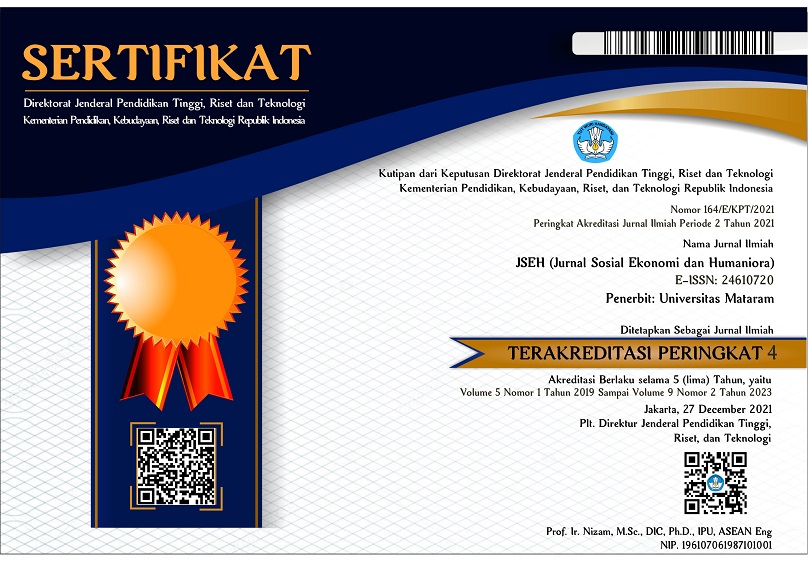Value Co-Creation An Exploratory Study of Sagala Multi-Brand Virtual Kitchen
DOI:
https://doi.org/10.29303/jseh.v9i1.205Keywords:
Value Co-Creation, The DART Model, Cloud Kitchen, Virtual Kitchen, Culinary BusinessAbstract
Culinary businesses accounted for 40% of Indonesian MSMEs at the height of the COVID-19 pandemic, making them one of the most affected industries. The transformation of the business model into a cloud kitchen or virtual kitchen is one of the innovation methods that can benefit the post-pandemic situation. This business model is thought to offer a value co-creation strategy. The authors note that Sagala, one of the virtual kitchens, has both a strong future and a low entry barrier. In order to analyze and assess Sagala's value co-creation, this study will employ The DART approach. Interviews with individuals from the staff, delivery, and customer categories were done as part of this exploratory study. Furthermore, the results show that Sagala's value co-creation initiative is a success, but conversation, particularly with delivery personnel, still has to be enhanced. Therefore, it is advised to create a framework to accept complaints and suggestions from both customers and delivery personnel. It is advised to create the value co-creation mechanism for the cloud kitchen company as further research.
References
REFERENCES
Blank, S., & Dorf, B. (2012). The startup owner's Manual: The Step-by-step guide for building a great company. K & S Ranch Press.
Creswell, J. W., & Creswell, J. D. (2018). Research design: Qualitative, quantitative, and mixed methods approaches. SAGE Publications, Inc.
Ehsan, Z.-A. (2021). Defining a startup - a critical analysis. SSRN Electronic Journal. https://doi.org/10.2139/ssrn.3823361
Elman, C., Gerring, J., & Mahoney, J. (2020). The production of knowledge: Enhancing progress in social science. Cambridge University Press.
Given, L. M. (Ed.). (2008). The sage encyclopedia of qualitative research methods. Sage.
Habibullah, C. F., & Fitria, S. E. (2019). Analysis Of The Implementation Of Value Co-Creation In Development Of New Products (Case Study At Maradeca Coffee Store, Kota Bandung) . e-Proceeding of Management, 6, 2044–2051.
Hatammimi, J., & Thahara, A. (2022). Capturing competitive advantage through product innovation: Study of a small culinary business. European Conference on Innovation and Entrepreneurship, 17(1), 258–265. https://doi.org/10.34190/ecie.17.1.492
Leonard, K. K. (Ed.). (2005). Encyclopedia of social measurement. Elsevier.
Miles, M. B., Huberman, A. M., & Saldaña Johnny. (2014). Qualitative Data Analysis: A methods sourcebook. Sage.
Prahalad, C. K., & Ramaswamy, V. (2004). Co‐creating unique value with customers. Strategy
& Leadership, 32(3), 4–9. https://doi.org/10.1108/10878570410699249
Ramaswamy, V., & Ozcan, K. (2014). The co-creation paradigm. Stanford Business Books, an imprint of Stanford University Press.
ResearchandMarkets. (2021). Global Cloud Kitchen Market Growth Trends to 2025: Rising demand for personalization and the emergence of the lazy economy. GlobeNewswire News Room. Retrieved August 12, 2022, from https://www.globenewswire.com/newsrelease/2021/12/31/2359620/28124/en/Global-Cloud-Kitchen-Market-Growth-Trends-to-2025-Rising-Demand-for-Personalization-and-the-Emergence-of-the-Lazy Economy.html
Rheny, S. (2022). Cloud kitchen, Konsep Bisnis Kuliner Baru Yang Sedang hits Saat Ini! TALENTS. Retrieved July 27, 2022, from https://www.ekrut.com/media/cloud-kitchen
Riad, S. S. M., & Kaufmann, H. R. (2017). Entrepreneurial challenges in the 21st century: Creating stakeholder value co-creation. Palgrave Macmillan.
Rose, D. S. (2016). The Startup Checklist: 25 steps to a scalable, high-growth business. Wiley.
Roser, T., Samson, A., Humphreys, P., & Valdivieso, E. C. (2009). Co-Creation: New Pathways to Value An Overview. Promise Corporation.
Sagala. (2022). Pasti Rasanyapasti kenyangnya. For the Joy of Full Tummy. Retrieved November 18, 2022, from https://www.eatsagala.id/Site/Home
Sugiyono. (2013). Metode Penelitian Kuantitatif, Kualitatif dan R&D. Bandung: Alfabeta.CV
Thiel, P., & Masters, B. (2015). Zero to one notes on startups, or how to build the 71 future. Virgin Books
Tracy, S. J. (2020). Qualitative research methods: Collecting evidence, crafting analysis, Communicating Impact. Wiley Blackwell.
Vega-Vazquez, M., Ángeles Revilla-Camacho, M., & J. Cossío-Silva, F. (2013). The value co-creation process as a determinant of customer satisfaction. Management Decision, 51(10), 1945–1953. https://doi.org/10.1108/md-04-2013-0227
Yusra, Y. (2022). Mendongkrak Bisnis UMKM kuliner melalui "cloud kitchen" dan "food delivery". DailySocial.id. Retrieved August 12, 2022, from
https://dailysocial.id/post/cloud-kitchen-food-delivery-umkm-kuliner-grabfood-yummycorp-dailybox
Zhafira, A. N. (2021). Bisnis kuliner berkontribusi Besar Saat pandemi. Antara News. Retrieved September 12, 2022, from https://www.antaranews.com/berita/2390809/bisnis-kulinerberkontribusi-besar-saat-pandemi
Downloads
Published
How to Cite
Issue
Section
License
Copyright (c) 2023 Jurry Hatammimi, Tediany Dwi Amiranti

This work is licensed under a Creative Commons Attribution-NonCommercial 4.0 International License.








